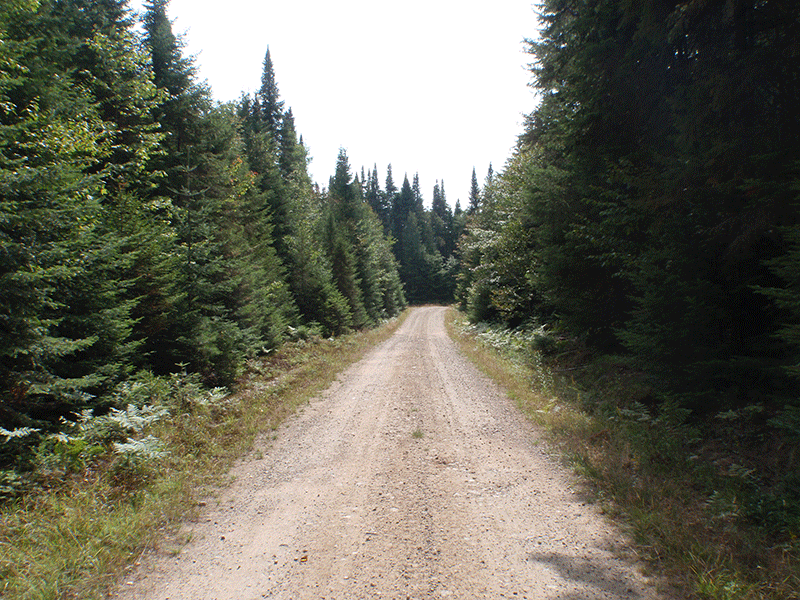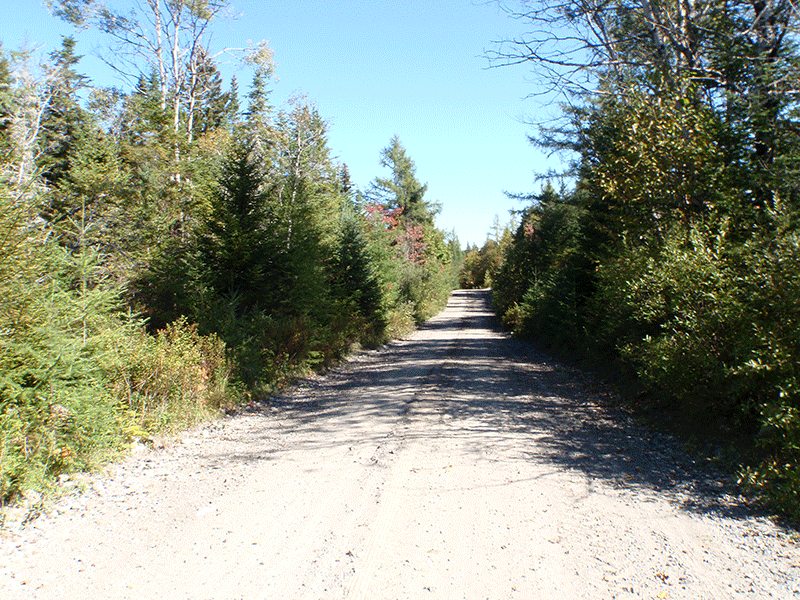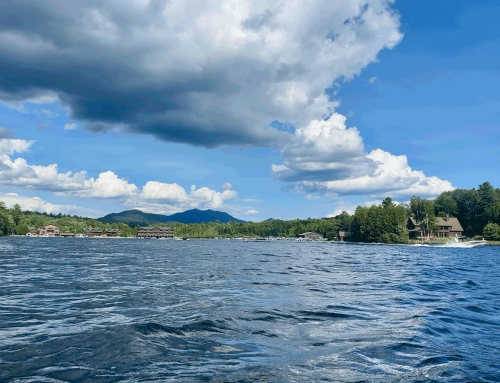We need your help to write a public comment to help stop state agencies from expanding roads for motor vehicles on the Forest Preserve!
The Adirondack Park Agency (APA) and the Department of Environmental Conservation (DEC) are holding a public hearing seeking input regarding an official “interpretation” of the Adirondack Park State Land Master Plan (APSLMP) Wild Forest Basic Guideline No. 4. This guideline regulates the mileage of motor vehicle roads on lands classified as Wild Forest in the Forest Preserve. Wild Forest lands are those that allow a greater intensity of public outdoor recreation and have many miles of mountainbike trails, snowmobile trails, and roads for motor vehicles.
Public comments are needed by July 12th!
How the APA chooses to “interpret” this part of the APSLMP will significantly impact the future of 1.3 million acres of the Forest Preserve classified as Wild Forest.
The APSLMP sets out the rules and guidelines for protecting natural resources and managing public recreation on the Forest Preserve in the Adirondack Park.
In the APSLMP, Wild Forest Basic Guideline No. 4 states:
Public use of motor vehicles will not be encouraged and there will not be any material increase in the mileage of roads and snowmobile trails open to motorized use by the public in wild forest areas that conformed to the master plan at the time of its original adoption in 1972. (p. 36)
In hearing materials provided to the public, the APA states: “The interpretation of Basic Guideline No. 4 will establish a baseline for road mileage on Wild Forest classified lands. The interpretation of this guideline of the Adirondack Park State Land Master Plan will better inform and support the development of Unit Management Plans (UMPs) that conform with the Adirondack Park State Land Master Plan.”
The APA’s decision to move ahead with this formal interpretation is problematic as the APA has worked assiduously in the last two decades to bend the rules to expand motor vehicle use in the Forest Preserve. Protect the Adirondacks believes that the “no material increase” clause is an effective cap on the mileage of roads in Wild Forest Areas.
It’s important for the APA-DEC to understand that there is no greater negative impact to an intact forest system than building a road. At the federal level, the “roadless rule” for National Forest areas is being implemented after having been gutted by the Trump Administration. New York State should not work to extend the policies of the Trump Administration to our Forest Preserve. APA-DEC has already exceeded the mileage cap in Wild Forest Basic Guideline No. 4.
The language in Wild Forest Basic Guideline No. 4 is deliberate that “public use of motor vehicles will not be encouraged” in the Adirondack Forest Preserve. To strengthen this point, it says “there will not be any material increase in the mileage of roads and snowmobile trails open to motorized use by the public in wild forest areas that conformed to the master plan at the time of its original adoption in 1972.” (p. 36) This should be read as a functional cap on road mileage in Wild Forest areas in the Forest Preserve. As shown below, we think the APA-DEC is misreading Wild Forest Basic Guideline No. 4 and that this clause covers all roads in Wild Forest areas.
In its public hearing documents, the APA has posted four questions to the public with regards to how it should interpret Wild Forest Basic Guideline No. 4. These questions are:
- What was the existing road mileage on lands classified as Wild Forest in 1972?
- What is the existing road mileage on lands classified as Wild Forest today?
- What constitutes a material increase in road mileage?
- Does the Department of Environmental Conservation Commissioner’s Policy-3 mileage meet the definition of a road in the SLMP and therefore require inclusion in the total Wild Forest road mileage calculation?
DEC-APA analysis tells us that 206.6 miles of public roads are open in Wild Forest areas in 2022, which is down slightly by five miles from the 1972 total of 211.6 miles. This number does not include administrative roads in Wild Forest areas managed by the DEC or roads where there are private access rights. Public hearing materials did not provide data on the total mileage of these roads in Wild Forest areas, which is considerable. Nor does this figure include the total mileage of roads open to the public for motorized access under the “Galusha” settlement/NYSDEC CP-3 policy for disabled access. In this way, the total scope of roads in Wild Forest areas is not being considered.
The ways that the APA and DEC choose to frame and answer the questions above will have far-reaching impacts on the natural resources and public use of the Forest Preserve. Protect the Adirondacks believes that Wild Forest Basic Guideline No. 4 needs to be evaluated and interpreted in concert with other relevant parts of the APSLMP that specifically direct Forest Preserve managers to limit the mileage of roads on the Forest Preserve. Protect the Adirondacks believes that Wild Forest Basic Guideline No. 4 pertains to all roads in Wild Forest areas, whether public, administrative, or roads open to the public under the CP-3 policy for disabled access. We are concerned that the APA-DEC’s decision not to include administrative roads and CP-3 roads in its road mileage totals in Wild Forest areas is an effort to circumvent and work around the restrictions in the “no material increase” clause.
The APA and DEC also need to look at the hundreds of miles of public motor vehicle roads open on state-owned conservation easements, which directly affect this issue. Similarly, the APA-DEC needs to look at the scores of miles of roads, both those open to the public and administrative, in areas of the Forest Preserve classified as Primitive, Intensive Use, State Administration, Canoe, and Historic.
Protect the Adirondacks is also concerned about the APA’s decision to formally interpret Wild Forest Basic Guideline No. 4 at this moment in time because it fits with a pattern over the last dozen years where the APA has assiduously worked to expand public and state administrative motor vehicle access to the Forest Preserve.
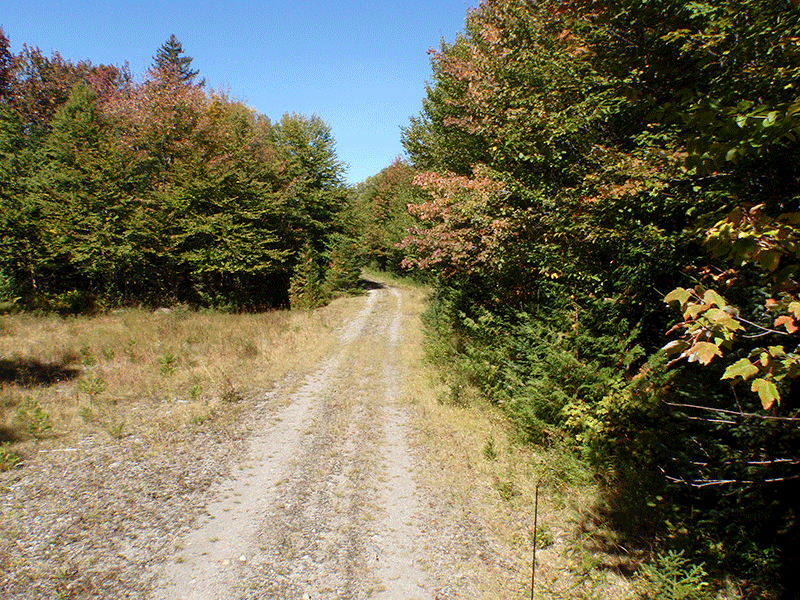
State efforts to expand the total miles of roads in the Forest Preserve undermines ecological integrity.
What is a Road?
The ways that motorized use is regulated on the Forest Preserve in the APSLMP starts with the definition of a “road.” The APLSMP defines a road this way:
Road‑‑an improved or partially improved way designed for travel by automobiles and which may also be used by other types of motor vehicles except snowmobiles, unless the way is a designated snowmobile trail; and is,
(i) either maintained by a state agency or a local government and open to the general public;
(ii) maintained by private persons or corporations primarily for private use but which may also be open to the general public for all or a segment thereof; or,
(iii) maintained by the Department of Environmental Conservation or other state agency and open to the public on a discretionary basis. (p. 20)
This definition has a direct bearing on the APA-DEC interpretation of the no material increase clause. The road definition is broad and all-encompassing. Its comprehensive scope is deliberately stated as “an improved or partially improved way,” which is designed to cover all motor vehicle routes, whether they are “maintained by a state agency or a local government and open to the general public.” The all-encompassing definition includes roads “maintained by private persons or corporations” and from end to end as stated in “for all or a segment thereof.” This definition deliberately includes all roads on the Forest Preserve, whether maintained by a state agency or other entity, and whether or not they are open to the public.
In essence, a practical application of this definition means that if it looks like a road, is used by motor vehicles under any circumstance as a road, has culverts like a road, has bridges capable of supporting motor vehicles, and is maintained like road, then it’s a road.
APSLMP goes further than just “roads” and also deliberately and importantly defines “administrative roads” this way:
Administrative Roads–an improved way maintained by the Department of Environmental Conservation for the principal purpose of facilitating administration of state lands or of allowing access for firefighting equipment and not normally open for public use of motorized vehicles. This type of road has been called a State Truck Trail in older editions of this Plan. (p. 17)
The purpose of including this definition in the APSLMP is to highlight the fact that even roads where public use is limited by the DEC are indeed roads on the Forest Preserve. Once again, if it looks like a road, is used by motor vehicles under any circumstance as a road, and is maintained like road, then it’s a road.
The APSLMP lays out yet more guidance to Forest Preserve managers in the “Roads and Administrative Roads” section in the Wild Forest section. The APSLMP lays out the following guidance:
- Continued use of existing roads, snowmobile trails and administrative roads by administrative personnel in wild forest areas will be permitted, to the extent necessary, to reach, maintain and construct permitted structures and improvements.
- Existing roads or snowmobile trails, now open to and used by the public for motor vehicle use in wild forest areas, may continue to be so used at the discretion of the Department of Environmental Conservation, provided such use is compatible with the wild forest character of an area.
- Established roads or snowmobile trails in newly‑acquired state lands classified as wild forest may be kept open to the public, subject to basic guideline 4 set forth above and in the case of snowmobile trails to the special guidelines for such trails set forth below, at the discretion of the Department of Environmental Conservation, provided such use is compatible with the wild forest character of the area.
- No new roads will be constructed in wild forest areas nor will new administrative roads be constructed unless such construction is absolutely essential to the protection or administration of an area, no feasible alternative exists and no deterioration of the wild forest character or natural resource quality of the area will result. (p. 38-39)
These passages show that while the APA-DEC has discretion on where to allow roads, they are allowed only “to the extent necessary” and must be “compatible with the wild forest character of an area.” Roads on newly purchased lands may be “kept open to the public” subject to the “no material increase clause” and at the “discretion” of the DEC if they are “compatible with the wild forest character of an area.” This section was written in recognition that nothing changes wild forest character more than motor vehicles, which are highly disruptive to natural and wild areas. This is the central reason why motor vehicles are expressly prohibited in Wilderness areas and why they should be minimized and rare in Wild Forest areas.
In total, while the APSLMP intended to allow limited motorized uses in Wild Forest Areas in the Forest Preserve it also sought at the same time to cap and tightly regulate their use. A reading of all of the attendant parts of the APSLMP that regulate roads in Wild Forest areas shows that roads should not be expanded beyond the 1972 level no matter how much new Forest Preserve is acquired and classified as Wild Forest. The APSLMP was written with the intent to allow roads and motor vehicles only where absolutely necessary, and to limit such use on the Forest Preserve sharply.
A fair reading of the APSLMP requires that the total universe of roads in the Wild Forest areas, including administrative roads, be included in an assessment of Wild Forest Basic Guideline No. 4. By any rational standard administrative roads are roads in the Forest Preserve.
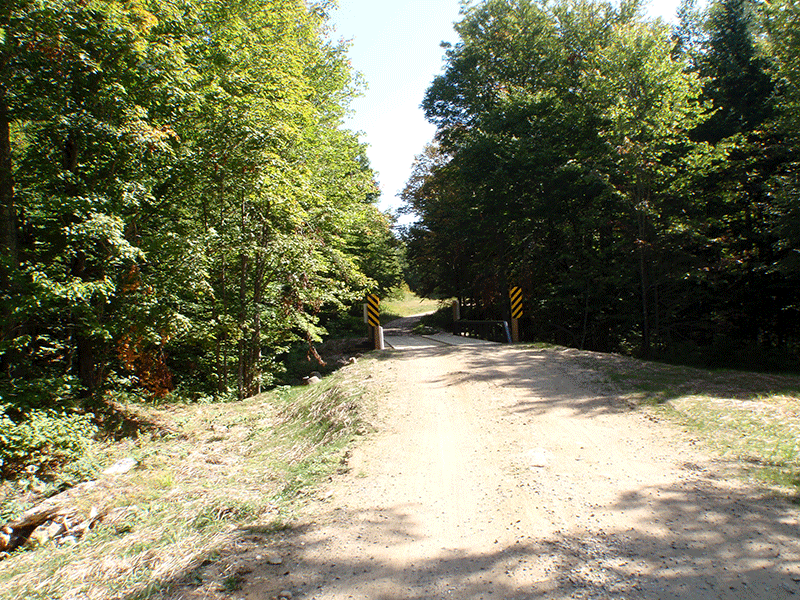
If it looks like a road, is used by motor vehicles under any circumstance as a road, has culverts like a road, has bridges capable of supporting motor vehicles, and is maintained like road, then it’s a road.
Galusha Settlement/CP-3 Roads
The DEC-APA has also decided not to include the universe of roads open to the public under special CP-3 permits. One part of the definition of a “road” in the APSLMP is roads “maintained by the Department of Environmental Conservation or other state agency and open to the public on a discretionary basis.” CP-3 roads are “open to the public on a discretionary basis.” Furthermore, the CP-3 policy differentiates between “roads” and “trails.” DEC only allows motor vehicles on roads, such as pickup trucks or sedans, while some “trails” are open to All Terrain Vehicles. That CP-3 roads are maintained for such public use on a discretionary basis means that they should be included in the road mileage totals under Basic Wild Forest Guideline No. 4.
A fair reading of the APSLMP requires that the total universe of roads in Wild Forest areas, including CP-3 roads, be included in an assessment of Wild Forest Basic Guideline No. 4.
Once again, it is our position that if it looks like a road, is used by motor vehicles under any circumstance as a road, and is maintained like road, then it’s a road. By any rational standard CP-3 roads are roads in the Forest Preserve.
Public Roads and Conservation Easements
In assessing Basic Wild Forest Guideline No. 4, the APA-DEC should also consider the mileage of public roads on conservation easement lands. The APSLMP refers to the importance of state-owned conservation easements and enumerates them in Appendix 2 where 699,442 acres of state easements are detailed.
Protect the Adirondacks estimates that there are over 900 miles of roads on state-owned conservation easements lands. Of these, we calculate that at least 500 miles of roads are open for some form of public motor vehicle use, though we note that the mileage of snowmobile trails is even greater. There are many cases where roads are connected between conservation easements and the Forest Preserve or where roads on easements provide public access to the Forest Preserve. From an administrative access standpoint, state agencies and personnel have carte blanche access to the full scope of roads on easement lands. The APA-DEC should not put on administrative blinders and pretend that throughout the Adirondacks, and mixed together like a patchwork quilt with Forest Preserve lands and roads, the DEC has not prioritized the acquisition of public motorized recreation use and access rights on conservation easement lands.
One fundamental purpose of state-owned conservation easement lands is that they have long been recognized as a recreational safety valve for the Forest Preserve where more intensive forms of motorized recreational uses are appropriate. This is why the state has sought to chiefly purchase extensive motor sports rights on easement lands to a far greater degree than any other recreational use. While motor vehicle roads are limited on the Forest Preserve, and correctly so, they are abundant and continue to grow decade by decade on state-owned conservation easement lands. While the no material increase clause has capped road mileage in Wild Forest areas in the Adirondack Park, we’ve seen an ever-growing mileage of public motor vehicle roads on conservation easement lands.
Roads in Primitive, Historic, Canoe, and Intensive Use Areas in the Forest Preserve
Protect the Adirondacks notes that the universe of various roads authorized on the Forest Preserve goes beyond Wild Forest areas and includes extensive mileage in Canoe, Historic, Intensive Use, Primitive, and State Administration areas. Moreover, it’s important to note that in its zeal to expand motorized use of the Forest Preserve, the APA in 2016 amended the APSLMP to allow an extensive road network in the Essex Chain Lakes Primitive Area.
The APA’s framing of this public hearing solely within the context of Wild Forest Basic Guideline No. 4 does not address the total impact of roads within the Adirondack Forest Preserve or the overall intent of the APSLMP.
State Agencies Think a 15% Increase in Total Road Miles is Appropriate; We disagree
APA-DEC has calculated that the existing total roads mileage in Wild Forest areas of the Forest Preserve to be 206.6 miles. For the purpose of this public hearing, APA-DEC has proffered that a 15% increase in the total allowable mileage of roads in Wild Forest areas complies with the directive for “no material increase” in Wild Forest Basic Guideline No. 4. Protect the Adirondacks believes that 15% is much too high. We believe that 15% constitutes a “material” increase.
Consider that for many people in business who experience a 15% increase in their costs, that would be seen as substantial and “material.” Anyone in business who sees a 15% increase in their profits will likely also see that as substantial and “material.” Anyone who pays rent and experiences a 15% increase, where an $800 monthly rent payment is raised $120 to $920 will surely see that as substantial and “material.” Staff at the APA or DEC who suddenly received a 15% pay cut would unarguably see that as substantial and “material.” The US inflation rate in May 2022 was 8.6% and that’s causing a political firestorm. This month the Federal Reserve raised its benchmark interest rates three-quarters of a percentage point and that was billed as the most substantial and aggressive hike since the 1990s. By any reasonable standard a 15% increase is material and substantial and violates Wild Forest Basic Guideline No. 4. A reasonable interpretation of the “no material increase” clause would be an increase in the low single digits of 2-3%.
Submit Your Public Comment Today
Public comments are needed by July 12th!
Please write your own comment letter to the APA by July 12th or you can use the form below to send an automatic comment.
Here’s where to submit your own letter:
Megan Phillips
Adirondack Park Agency
P.O. Box 99
Ray Brook, NY 12977
By email:
SLMP_UMP_Comments@apa.ny.gov
Thank you very much for taking a stand to protect the Forest Preserve!

